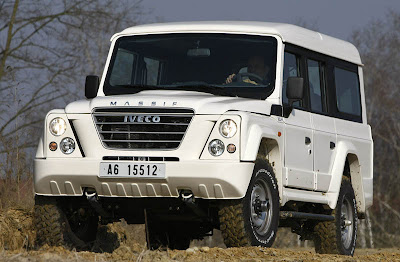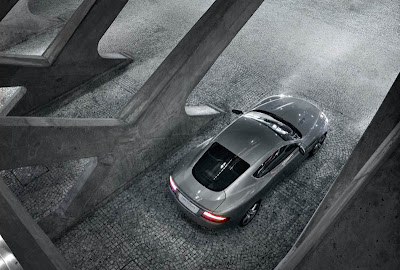The Iveco Massif signals Iveco's first entry into the light off-road vehicle segment, and with two body styles. The spirit of the Massif follows in the tyre tracks of the Fiat Campagnola, the Italian Army standard-issue jeep designed in 1951 that became an icon in Italy in an age when the country still lacked a modern road infrastructure. The Campagnola was an important symbol for postwar Italy and the reconstruction of the 1950s, still fresh in the Italian collective memory.
Iveco - a full range of all-wheel-drive vehicles
Iveco Massif 4x4 competes in a small but very important niche market of 4x4 work vehicles. Iveco Massif is produced jointly with Spanish maker Santana: their original vehicle was completely revised by Iveco experts with support on a massive scale in terms of technologies and solutions derived from the Daily. Iveco Massif is actually the true heir to the Daily 4x4 floor plan, well-known for its performance in military and civilian situations in the form of the VM 90, used by the armed forces and civil defence corps of many countries. Iveco Massif shares its engageable all-wheel-drive architecture, with the transfer box flanged to the gearbox to lower the vehicle's profile as far as possible, making it perfectly adapted for long, rapid on-road transfers and demanding off-road missions at the destination.
Outstanding power train combination
Iveco Massif uses two highly successful FPT engines: the 3.0 HPI rated at 146Cv and 350Nm of torque and the 176CV HPT with 400 Nm of torque, coupled to the ZF 6S400 6-speed transmission. This outstanding power train combination is taken from the Daily product range and is well proven on all counts of reliability, performance and low fuel consumption.
The values of Iveco Massif
Iveco Massif was created from sharing the same values that made the All Blacks the most famous rugby team in the world, following in the tyre tracks of the new Stralis, Trakker and Daily 4x4 models.

In addition to the four Iveco values - Commitment, Reliability, Performance, and Team Spirit - Massif also inherits the Stralis's product value, Power, reaffirming one of the strong points that distinguish the excellence of Iveco's engineering solutions.
Power
For Iveco Massif, power means offering the latest generation 3-litre EGR engine with a rated power of 146 Cv and a maximum torque of 350 Nm. An efficient, reliable engine with optimized power and torque delivery over a wide range of engine speeds to ensure maximum power availability even in arduous conditions. Also available is the 176 CV version with Variable Geometry Turbocharger, developing 400 Nm of torque, recognised to be the best engine in its class.
Performance
For Iveco Massif, Performance is supporting the customer's business value. It means raising productivity and reducing running costs. Iveco Massif's assets are optimised bodybuilder intervention, servicing downtime, and consumption. Periodic maintenance time is minimised so that the vehicle spends as little time as possible in the workshop. And an always-present, vital consideration is fuel cost: Massif's Euro 4 engine returns excellent fuel consumption.
IVECO MASSIF IN DETAIL
The Iveco Massif vehicle and the industry sector in which it competes is new to Iveco. Today Iveco offers customers in this important niche products and services that fill the entire range of their customers' needs. When commercial vehicles are required to go off road in the most arduous of conditions - both weather and terrain - it is never just to supply equipment: there are people in that vehicle, too. Iveco's all-wheel-drive products - Trakker, Eurocargo 4x4 and Daily 4x4 - handle this task perfectly.

Cab and chassis features
All Iveco Massif versions are mounted on a separate chassis with axles mounted on parabolic leaf springs. This is a no-compromise solution: a separate chassis ensures the high structural stresses incurred during serious off road applications are not carried into the body structure to the extent that body durability is compromised.
Interior enhancements such as cloth or leather seat covering materials are available, as is a leather-covered steering wheel rim. For missions where severe (pressure hose) cleaning of the cab interior is required, there are variants with highly-resistant rubber floor mats and vinyl seat covering.
Radio/CD player and satellite navigation systems are available to order. Seat availability is matched to body type; the chassis cab and pick-up versions are available only with the standard driver and single passenger seat, the 3-door station wagon has a 4-seat (2+2) layout with the simple 2 seating rows option and the 5-door station wagon has a 5-seat (2+3) layout with the simple 2 seating rows option or a 7-seat (2+3+2) option.
Transmission and transfer Box
The ZF 6S400 overdrive 6-speed transmission is coupled to the remote-mounted Santana transfer box, providing either 4x2 or 4x4 traction. In high range the drive is to the rear wheels only, unless the specific selector is set to 4-wheel-drive. Selecting low range automatically engages 4-wheel-drive. The transfer box is not equipped with a differential facility and so, under 4-wheel-drive conditions, loss of adherence by either the front or rear wheels does not result in loss of traction. In addition an optional rear axle differential lock is available, as is an automatic front hub freewheel facility which reduces transmission wind-up when 4-wheel-drive is used on firm surfaces. The transmission in combination with the transfer box provides for 12 forward gear ratios and 2 reverse gear ratios.
Front and rear driven axles
Beam drive axles are used both front and rear and have a common final drive ratio of 3.909:1. The final drive gearing used on the front axle is helicoidal whereas that on the rear axle is a hypoid gear set in order to provide improved ground clearance for the centrally-mounted drive shaft.
Wheels and tyres
The standard version comes with 235/85R16 all-terrain tyres. Off-road tyres mounted on steel wheel rims are available as an option, as are aluminium wheel rims.
Suspension system
Parabolic leaf springs are used for the front and rear axles, performing the dual role of chassis suspension and drive axle location. This relatively simple suspension layout provides for better drive and braking torque reactions without the need for extra links and bracketry, a definite plus for the serious off-road vehicle. Double action hydraulic dampers are used for the front axle and double action gas dampers are used for the rear, and anti-roll stabiliser bars are fitted front and rear.
Maximum front and rear axle plated masses are 1072 kg and 2150 kg respectively; plated vehicle mass is 3050 kg.
Braking system
A double 'H' hydraulic circuit with vacuum servo-assistance is used to actuate ventilated disc brakes on the front axle and simple discs on the rear axle. The parking brake is a cable-actuated drum brake mounted on the transmission transfer box and therefore giving the advantage of the park brake torque with a multiplication factor equal to the drive axle ratio. Mechanical brake force distribution is used for all models when the vehicle is under 4-wheel-drive operation, and the optional Antilock Brake System (ABS) provides an electronic brake force distribution under 4x2 driving conditions. The ABS can be deactivated for certain off-road conditions.

 The Porsche Panamera designers have succeeded in positioning it as a brand-new and truly different model while retaining the looks of a typical Porsche. Through its proportions, the Porsche Panamera stands out in its market segment: measuring 76 inches wide and 55.8 inches in height, it is wider and lower than comparable four-door models. The unmistakable GT silhouette is created by the car's overall length of 195.7 inches and short, sporting overhangs. In its styling and details, the Porsche Panamera follows the design philosophy refined over decades on the 911 and successfully implemented on the Boxster, Cayman and Cayenne.
The Porsche Panamera designers have succeeded in positioning it as a brand-new and truly different model while retaining the looks of a typical Porsche. Through its proportions, the Porsche Panamera stands out in its market segment: measuring 76 inches wide and 55.8 inches in height, it is wider and lower than comparable four-door models. The unmistakable GT silhouette is created by the car's overall length of 195.7 inches and short, sporting overhangs. In its styling and details, the Porsche Panamera follows the design philosophy refined over decades on the 911 and successfully implemented on the Boxster, Cayman and Cayenne. Pure Porsche DNA and comfort for four
Pure Porsche DNA and comfort for four The an elegant roof arch extends over the generous interior. Thanks to the unique and sporting architecture of the interior, the car's occupants are able to experience a cockpit-like atmosphere from all four seats. All occupants enjoy supreme comfort in both the front seats and the two contoured rear seats. The luggage compartment easily takes all passengers' luggage; the Panamera's variable space concept with folding rear backrests enables driver and passengers to adjust the luggage space to individual requirements. Finally, the coupe tailgate in the sporting rear end combines everyday usability with stylish elegance.
The an elegant roof arch extends over the generous interior. Thanks to the unique and sporting architecture of the interior, the car's occupants are able to experience a cockpit-like atmosphere from all four seats. All occupants enjoy supreme comfort in both the front seats and the two contoured rear seats. The luggage compartment easily takes all passengers' luggage; the Panamera's variable space concept with folding rear backrests enables driver and passengers to adjust the luggage space to individual requirements. Finally, the coupe tailgate in the sporting rear end combines everyday usability with stylish elegance. The Porsche Panamera built in Leipzig; powerful engines hail from Zuffenhausen.
The Porsche Panamera built in Leipzig; powerful engines hail from Zuffenhausen.













